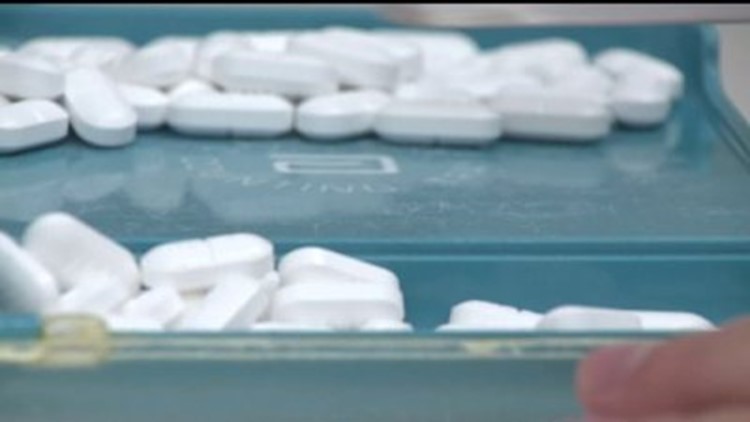Experts say the United States is in the throes of an opioid epidemic, as more than two million Americans have become dependent on or abused prescription pain pills and street drugs.
Opioids are drugs formulated to replicate the pain-educing properties of opium. They include both legal painkillers like morphine, oxycodone, or hydrocodone prescribed by doctors for acute or chronic pain, as well as illegal drugs like heroin or illicitly made fentanyl. The word “opioid” is derived from the word “opium.”
During 2017, there were more than 72,000 overdose deaths in the United States, including 49,068 that involved an opioid, according to a provisional CDC count. More than 130 people died every day from opioid-related drug overdoses in 2016 and 2017, according to the US Department of Health & Human Services (HHS).
The number of opioid prescriptions dispensed by doctors steadily increased from 112 million prescriptions in 1992 to a peak of 282 million in 2012, according to the market research firm IMS Health. The number of prescriptions dispensed has since declined, falling to 236 million in 2016. The number dropped 10.2% in 2017 from 2016, according to IQVIA (formerly IMS Health).
Common opioids:
Opioids bind to receptors in the brain and spinal cord, disrupting pain signals. They also activate the reward areas of the brain by releasing the hormone dopamine, creating a feeling of euphoria or a “high.”
Opioids such as morphine and codeine are naturally derived from opium poppy plants more commonly grown in Asia, Central America and South America. Heroin is an illegal drug synthesized from morphine.
Hydrocodone and oxycodone are semi-synthetic opioids, manufactured in labs with natural and synthetic ingredients. Between 2007 and 2016, the most widely prescribed opioid was hydrocodone (Vicodin). In 2016, 6.2 billion hydrocodone pills were distributed nationwide. The second most prevalent opioid was oxycodone (Percocet). In 2016, 5 billion oxycodone tablets were distributed in the United States.
The International Narcotics Control Board reported that in 2015, Americans represented about 99.7% of the world’s hydrocodone consumption.
Fentanyl is a fully synthetic opioid, originally developed as a powerful anesthetic for surgery. It is also administered to alleviate severe pain associated with terminal illnesses like cancer. The drug is up to 100 times more powerful than morphine. Just a small dose can be deadly. Illicitly produced fentanyl has been a driving factor in the number of overdose deaths in recent years.
Methadone is another fully synthetic opioid. It is commonly dispensed to recovering heroin addicts to relieve the symptoms of withdrawal.
People who become dependent on opioids may experience withdrawal symptoms when they stop taking the pills. Dependence is often coupled with tolerance, meaning that opioid users need to take increasingly larger doses of the medication for the same effect.
About 11.4 million Americans misused prescription pain medicine in 2016 and 2017, according to the HHS. About 886,000 people used heroin.
People who become dependent on pain pills may switch to heroin because it is less expensive than prescription drugs. The National Institute on Drug Abuse estimates that half of young people who inject heroin turned to the street drug after abusing prescription painkillers, also that three in four new heroin users start out using prescription drugs.
A drug called naloxone, available as an injection or a nasal spray, is used as a treatment for overdoses. It blocks or reverses the effects of opioids and is often carried by first responders.
Regulation and funding:
In 2013, the cost of medical care and substance abuse treatment for opioid addiction and overdose was an estimated $78.5 billion, according to a report in the journal Medical Care.
The 21st Century Cures Act, passed in 2016, allocated $1 billion over two years in opioid crisis grants to states, providing funding for expanded treatment and prevention programs. In April 2017, Health and Human Services Secretary Tom Price announced the distribution of the first round of $485 million in grants to all 50 states and US territories.
In August 2017, Attorney General Jeff Sessions announced the launch of an Opioid Fraud and Abuse Detection Unit within the Department of Justice. The unit’s mission is to prosecute individuals who commit opioid-related health care fraud. The DOJ is also appointing US attorneys who will specialize in opioid health care fraud cases as part of a three-year pilot program in 12 jurisdictions nationwide.
State legislatures are also introducing measures to regulate pain clinics and limit the quantity of opioids that doctors can dispense.
Emergence of a crisis:
1861-1865 – During the Civil War, medics use morphine as a battlefield anesthetic. Many soldiers become dependent on morphine after the war.
1898 – Heroin is first produced commercially by the Bayer Company. At the time, heroin is believed to be less habit-forming than morphine, so it is dispensed to individuals who are addicted to morphine.
1914 – Congress passes the Harrison Narcotics Act, which requires that doctors write prescriptions for narcotic drugs like opioids and cocaine. Importers, manufacturers and distributors of narcotics must register with the Treasury Department and pay taxes on products
1924 – The Anti-Heroin Act bans the production and sale of heroin in the United States.
1970 – The Controlled Substances Act becomes law. It creates groupings (or schedules) of drugs based on the potential for abuse. Heroin is a Schedule I drug while morphine, fentanyl, oxycodone (Percocet, OxyContin) and methadone are Schedule II. Vicodin – a hydrocodone-acetaminophen combination – was originally a Schedule III medication but wasn’t recategorized as a Schedule II drug until October 2014.
January 10, 1980 – A letter titled “Addiction Rare in Patients Treated with Narcotics” is published in the New England Journal of Medicine. It was not a study and looked at incidences of addiction in a very specific population of hospitalized patients who were closely monitored. However, it would become widely cited as proof that narcotics were a safe treatment for chronic pain.
1995 – OxyContin, a long acting version of oxycodone, which slowly releases the drug over 12 hours, is introduced and aggressively marketed as a safer pain pill by manufacturer, Purdue Pharma.
May 10, 2007 – The federal government brings criminal charges against Purdue Pharma for misleadingly advertising OxyContin as safer and less addictive than other opioids. The company and three executives are charged with “misleading and defrauding physicians and consumers.” Purdue Pharma and the executives plead guilty, agreeing to pay a $634.5 million in criminal and civil fines. The three executives plead guilty on criminal misdemeanor charges and are later sentenced to probation.
2010 – FDA approves an “abuse-deterrent” formulation of OxyContin, to help curb abuse. However, people still find ways to abuse it.
May 20, 2015 – The DEA announces that it has arrested 280 people, including 22 doctors and pharmacists, after a 15-month sting operation centered on health care providers who dispense large amounts of opioids. The sting, dubbed Operation Pilluted, is the largest prescription drug bust in the history of the DEA.
March 18, 2016 – The CDC publishes guidelines for prescribing opioids for patients with chronic pain. Recommendations include prescribing over-the-counter pain relievers like acetaminophen and ibuprofen in lieu of opioids. Doctors are encouraged to promote exercise and behavioral treatments to help patients cope with pain.
March 29, 2017 – President Donald Trump signs an executive order calling for the establishment of the President’s Commission on Combating Drug Addiction and the Opioid Crisis. New Jersey Governor Chris Christie is selected as the chairman of the group, with Trump’s son-in-law, Jared Kushner, as an adviser.
July 31, 2017 – After a delay, the White House panel examining the nation’s opioid epidemic releases its interim report, asking rump to declare a national public health emergency to combat the ongoing crisis
September 22, 2017 – The pharmacy chain CVS announces that it will implement new restrictions on filling prescriptions for opioids, dispensing a limited seven-day supply to patients who are new to pain therapy.
November 1, 2017 – The opioid commission releases its final report. Its 56 recommendations include a proposal to establish nationwide drug courts that would place opioid addicts in treatment facilities rather than prison.
February 9, 2018 – A budget agreement signed by Trump authorizes $6 billion for opioid programs, with $3 billion allocated for 2018 and $3 billion allocated for 2019.
February 27, 2018 – Attorney General Jeff Sessions announces a new opioid initiative: the Prescription Interdiction & Litigation (PIL) Task Force. The mission of the task force is to support local jurisdictions that have filed lawsuits against prescription drugmakers and distributors.
March 19, 2018 – The Trump administration outlines an initiative to stop opioid abuse. The three areas of concentration are law enforcement and interdiction; prevention and education via an ad campaign; and job-seeking assistance for individuals fighting addiction.
April 9, 2018 – The US surgeon general issues an advisory recommending that Americans carry the opioid overdose-reversing drug, naloxone. A surgeon general advisory is a rarely used tool to convey an urgent message. The last advisory issued by the surgeon general, more than a decade ago, focused on drinking during pregnancy.
May 1, 2018 – The Journal of the American Medical Association publishes a study that finds synthetic opioids like fentanyl caused about 46% of opioid deaths in 2016. That’s a three-fold increase compared with 2010, when synthetic opioids were involved in about 14% of opioid overdose deaths. It’s the first time that synthetic opioids surpassed prescription opioids and heroin as the primary cause of overdose fatalities.
June 7, 2018 – White House announces a new multimillion dollar public awareness advertising campaign to combat opioid addiction. The first four ads of the campaign are all based on true stories illustrating the extreme lengths young adults have gone to get a hold of the powerful drugs.
October 24, 2018 – Trump signs sweeping legislation into law that includes provisions aimed at promoting research to find new drugs for pain management that will not be addictive. It also expands access to treatment for substance use disorders for Medicaid patients.
December 12, 2018 – According to the latest numbers from the CDC’s National Center for Health Statistics, fentanyl is now the most commonly used drug involved in drug overdoses. The rate of drug overdoses involving the synthetic opioid skyrocketed by about 113% each year from 2013 through 2016.



